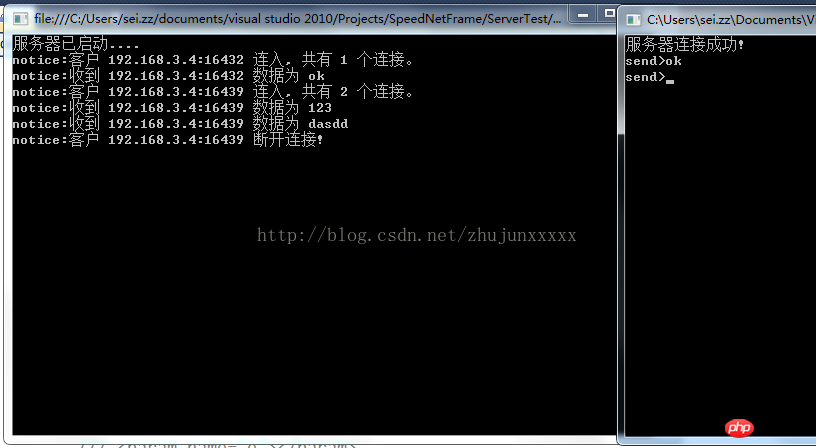C#高性能Socket服务器SocketAsyncEventArgs的实现(IOCP)
原创性申明
本文作者:小竹zz 博客地址:http://www.php.cn/转载请注明出处
引言
我一直在探寻一个高性能的Socket客户端代码。以前,我使用Socket类写了一些基于传统异步编程模型的代码(BeginSend、BeginReceive,等等)也看过很多博客的知识,在linux中有poll和epoll来实现,在windows下面
微软MSDN中也提供了SocketAsyncEventArgs这个类来实现IOCP 地址:http://www.php.cn/
NET Framework中的APM也称为Begin/End模式。这是因为会调用Begin方法来启动异步操作,然后返回一个IAsyncResult 对象。可以选择将一个代理作为参数提供给Begin方法,异步操作完成时会调用该方法。或者,一个线程可以等待 IAsyncResult.AsyncWaitHandle。当回调被调用或发出等待信号时,就会调用End方法来获取异步操作的结果。这种模式很灵活,使用相对简单,在 .NET Framework 中非常常见。
但是,您必须注意,如果进行大量异步套接字操作,是要付出代价的。针对每次操作,都必须创建一个IAsyncResult对象,而且该对象不能被重复使用。由于大量使用对象分配和垃圾收集,这会影响性能。为了解决这个问题,新版本提供了另一个使用套接字上执行异步I/O的方法模式。这种新模式并不要求为每个套接字操作分配操作上下文对象。
代码下载:http://www.php.cn/ 这里的代码优化了的
目标
在上面微软提供的例子我觉得不是很完整,没有具体一个流程,只是受到客户端消息后发送相同内容给客户端,初学者不容易看懂流程,因为我花了一天的时间来实现一个功能齐全的IOCP服务器,
效果如下

代码
首先是ICOPServer.cs 这个类是IOCP服务器的核心类,目前这个类是网络上比较全的代码,MSDN上面的例子都没有我的全
1 2 3 4 5 6 7 8 9 10 11 12 13 14 15 16 17 18 19 20 21 22 23 24 25 26 27 28 29 30 31 32 33 34 35 36 37 38 39 40 41 42 43 44 45 46 47 48 49 50 51 52 53 54 55 56 57 58 59 60 61 62 63 64 65 66 67 68 69 70 71 72 73 74 75 76 77 78 79 80 81 82 83 84 85 86 87 88 89 90 91 92 93 94 95 96 97 98 99 100 101 102 103 104 105 106 107 108 109 110 111 112 113 114 115 116 117 118 119 120 121 122 123 124 125 126 127 128 129 130 131 132 133 134 135 136 137 138 139 140 141 142 143 144 145 146 147 148 149 150 151 152 153 154 155 156 157 158 159 160 161 162 163 164 165 166 167 168 169 170 171 172 173 174 175 176 177 178 179 180 181 182 183 184 185 186 187 188 189 190 191 192 193 194 195 196 197 198 199 200 201 202 203 204 205 206 207 208 209 210 211 212 213 214 215 216 217 218 219 220 221 222 223 224 225 226 227 228 229 230 231 232 233 234 235 236 237 238 239 240 241 242 243 244 245 246 247 248 249 250 251 252 253 254 255 256 257 258 259 260 261 262 263 264 265 266 267 268 269 270 271 272 273 274 275 276 277 278 279 280 281 282 283 284 285 286 287 288 289 290 291 292 293 294 295 296 297 298 299 300 301 302 303 304 305 306 307 308 309 310 311 312 313 314 315 316 317 318 319 320 321 322 323 324 325 326 327 328 329 330 331 332 333 334 335 336 337 338 339 340 341 342 343 344 345 346 347 348 349 350 351 352 353 354 355 356 357 358 359 360 361 362 363 364 365 366 367 368 369 370 371 372 373 374 375 376 377 378 379 380 381 382 383 384 385 386 387 388 389 390 391 392 393 394 395 396 397 398 399 400 401 402 403 404 405 406 407 408 409 410 411 412 413 414 415 416 417 418 419 420 421 422 423 424 425 426 427 428 429 430 431 432 433 434 435 436 437 438 439 440 441 442 443 444 445 446 447 448 449 450 451 452 453 454 455 456 457 458 459 460 461 462 463 464 465 466 467 468 469 470 471 472 473 474 475 476 477 478 479 480 481 482 483 484 485 486 487 488 489 490 491 492 493 494 495 496 497 498 499 500 501 502 503 504 505 506 507 508 509 510 511 512 513 514 515 516 517 518 519 520 521 522 523 524 525 526 527 528 529 530 531 532 533 |
|
BufferManager.cs 这个类是缓存管理类,是采用MSDN上面的例子一样的 地址: http://www.php.cn/
SocketAsyncEventArgsPool.cs 这个类也是来自MSDN的 地址:http://www.php.cn/
需要的话自己到MSDN网站上去取,我就不贴出来了
服务器端
1 2 3 4 5 6 7 8 |
|
客户端
客户端代码也是很简单
1 2 3 4 5 6 7 8 9 10 11 12 13 14 15 16 17 18 |
|
client.cs
1 2 3 4 5 6 7 8 9 10 11 12 13 14 15 16 17 18 19 20 21 22 23 24 25 26 27 28 29 30 31 |
|
IOCPClient类,使用SocketAsyncEventArgs类建立一个Socket客户端。虽然MSDN说这个类特别设计给网络服务器应用,但也没有限制在客户端代码中使用APM。下面给出了IOCPClient类的样例代码:
1 2 3 4 5 6 7 8 9 10 11 12 13 14 15 16 17 18 19 20 21 22 23 24 25 26 27 28 29 30 31 32 33 34 35 36 37 38 39 40 41 42 43 44 45 46 47 48 49 50 51 52 53 54 55 56 57 58 59 60 61 62 63 64 65 66 67 68 69 70 71 72 73 74 75 76 77 78 79 80 81 82 83 84 85 86 87 88 89 90 91 92 93 94 95 96 97 98 99 100 101 102 103 104 105 106 107 108 109 110 111 112 113 114 115 116 117 118 119 120 121 122 123 124 125 126 127 128 129 130 131 132 133 134 135 136 137 138 139 140 141 142 143 144 145 146 147 148 149 150 151 152 153 154 155 156 157 158 159 160 161 162 163 164 165 166 167 168 169 170 171 172 173 174 175 176 177 178 179 180 181 182 183 184 185 186 187 188 189 190 191 192 193 194 195 196 197 198 199 200 201 202 203 204 205 206 207 208 209 210 211 212 213 214 215 216 217 218 219 220 221 222 223 224 225 226 227 228 229 230 231 232 233 234 235 |
|
这个类我没有测试,但是理论上是没问题的。
以上就是C#,SocketAsyncEventArgs,服务器的内容,更多相关内容请关注PHP中文网(www.php.cn)!

热AI工具

Undresser.AI Undress
人工智能驱动的应用程序,用于创建逼真的裸体照片

AI Clothes Remover
用于从照片中去除衣服的在线人工智能工具。

Undress AI Tool
免费脱衣服图片

Clothoff.io
AI脱衣机

AI Hentai Generator
免费生成ai无尽的。

热门文章

热工具

记事本++7.3.1
好用且免费的代码编辑器

SublimeText3汉化版
中文版,非常好用

禅工作室 13.0.1
功能强大的PHP集成开发环境

Dreamweaver CS6
视觉化网页开发工具

SublimeText3 Mac版
神级代码编辑软件(SublimeText3)
 使用 C# 的活动目录
Sep 03, 2024 pm 03:33 PM
使用 C# 的活动目录
Sep 03, 2024 pm 03:33 PM
使用 C# 的 Active Directory 指南。在这里,我们讨论 Active Directory 在 C# 中的介绍和工作原理以及语法和示例。













